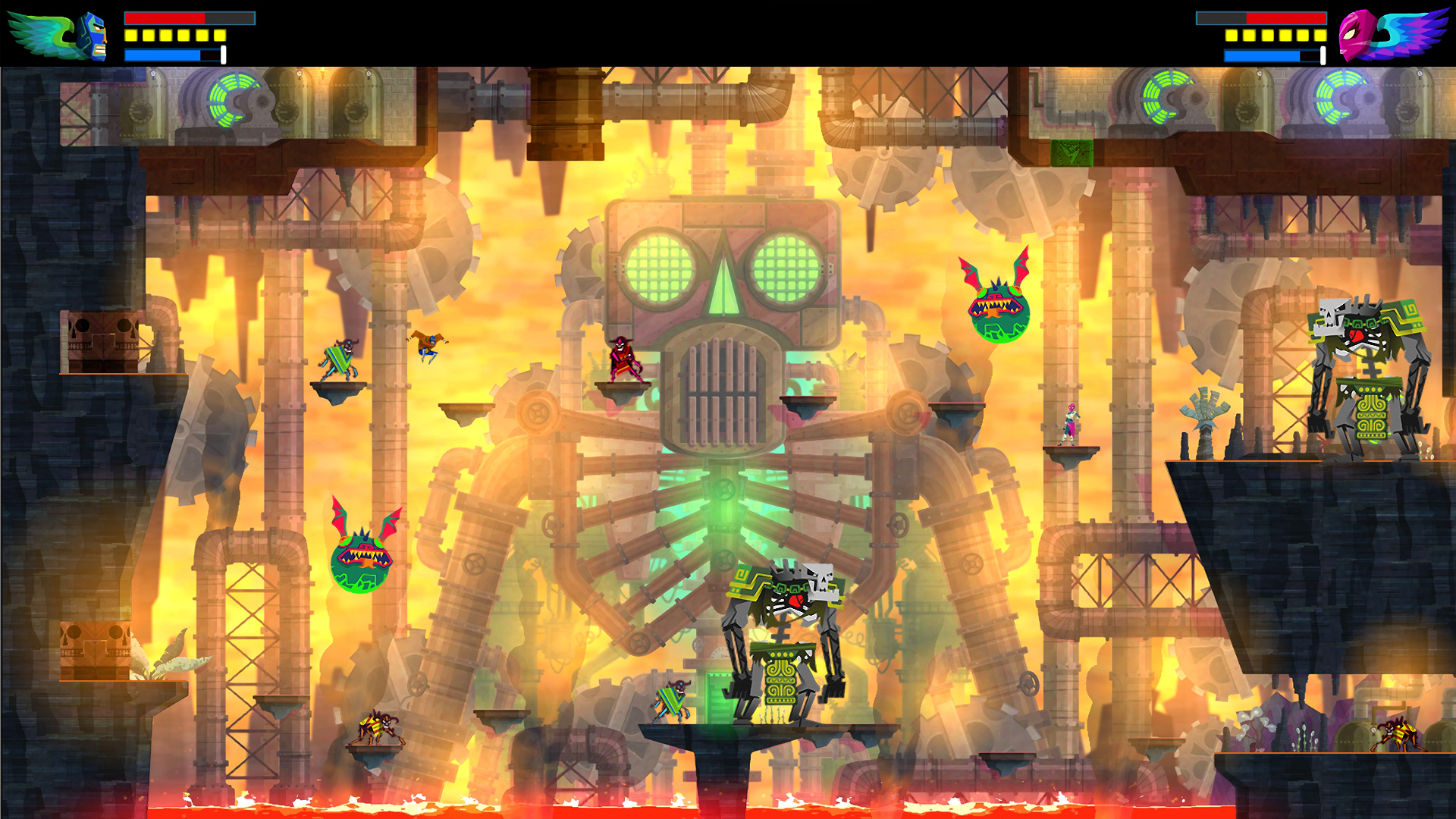
Welcome to the new school year, video game aficionados. Hopefully, you found some new titles over the summer and had the opportunity to revisit some old favorites. One of the games I replayed over the summer is Guacamelee!, and here’s my review of this unique little gem.
A side-scrolling Metroidvania with a focus on large arena brawls and challenging platforming segments, Guacamelee! entertains, challenges, and surprises, all in a brightly colored, stylized world that pops delightfully from the screen. Drawing creative inspiration from traditional Mexican folklore, Guacamelee! tells of the battle between Juan, an agave farmer who gains superhero powers when he dons a luchador mask, and Carlos Calaca, an evil skeleton who has kidnapped Juan’s love interest during a Dia de Los Muertos celebration. Wearing his mask, Juan travels expertly between the worlds of the living and the dead as he seeks to rescue his beloved and rid his humble farming village of the nefarious Carlos.
If you have read any of my previous game reviews, you know I favor indie games over titles from the AAA studios, and Guacamelee! is no exception. Produced by DrinkBox Studios, a small shop based in Toronto, Guacamelee! originally was released for PlayStation in 2013, with an enhanced re-release for other gaming systems coming to market one year later, and my seventh-grade self was a huge fan of the Wii U edition. The fact that I replayed the game this summer and now am spending the time to review it is a testament to the compelling nature of the product. The art in Guacamelee! is fantastic, and kudos are due to DrinkBox for celebrating the culture of Mexico in this unique way. Impressive also is the game’s soundtrack: the Mexican-inspired beat complements the game’s playful graphics, with the sound fresh enough to add another layer of interest to the game.
Unlike other Metroidvanias, the path through the world of Guacamelee! is mostly linear and always clear, but the difficulty curve of the game is so perfect that I do not mind the uncomplicated track. Complementing this mostly obvious pathway, the game’s unexpectedly robust combat is the real highlight. Varied throughout but consistently challenging, the combat utterly engages the player, captivating and amazing simultaneously; even with a new ability only every hour or two, the fighting never gets old, as Juan battles zombie armadillos, soulless banditos, and other creatively-conceived desert foes.
Every part of Juan’s moveset is fun and useful, encouraging you to string together long combos of actions that incorporate your entire skillset. The basic structure of each fight requires you to damage enemies while making liberal use of knockdowns and movement abilities to avoid damage. To this end, every move can be used both to deal damage and to avoid damage, ultimately testing your ability to employ strategy and crowd control, as you begin to see your enemies not only as threats but also as projectiles with which to stunlock the rest of the arena. One of my favorite parts of the game is Combo Chicken, a duel in the game’s Santa Luchita area where Juan encounters Poncho, an over-sized skeleton luchador. Success at Combo Chicken requires practice and patience and, as its name implies, the coordination to combine several different inputs simultaneously in order to create the specific combo that allows Juan to best Poncho.
Basic Attacks
Every enemy in the game can be stunlocked by any attack and always will be knocked down by your three-hit combo, all of your special moves, and throws. Because of this, individual enemies pose almost no threat, freeing up the game to throw large horde fights at you. Besides your three-hit combo, you also have an upward swing, to easily start juggles, and a double jump, for increased air control. Even from the beginning of the game, Juan is much more mobile than most enemies, creating the foundation for the strategic, movement-based combat system that is the main focus of the game.
Grab
Your primary method of crowd control, a grab can be performed on any enemy below about 25% health. After weakening the enemy, a grab only requires a one-button press to perform the grab and then one directional input to determine the direction of your throw. A thrown enemy will knockdown and damage other enemies they contact, often allowing you to effortlessly bowl over lines of enemies. You are invulnerable during the grab and throw animations, meaning an enemy with low health could be kept alive for use as a shield.
Movement
Your three primary movement abilities double as attacks, allowing for long chains of attacks to juggle enemies and dodge projectiles at the same time. Most arenas also incorporate platforms, and some platforming segments incorporate enemies, encouraging you to line up attacks which will move you around and knock enemies off platforms at the same time. These three movement abilities also function as a knockdown, allowing for further crowd control while you move around to close in on high priority targets.
Dodge
Unlike most games, your dodge comes with a very generous period of invincibility and quickly moves Juan a significant distance to the left or right. This means that as long as you are in a position to dodge, you don’t even have to worry about hitting a tight timing window to avoid damage. This reinforces the more strategic nature of the game’s large fights, and dodging becomes just a factor that forces you to move, requiring creative use of your other abilities to reposition yourself while continuing to do damage. Midway through, the game introduces enemies with attacks that ignore your invincibility while dodging. These attacks often have large areas of effect, reinforcing the use of movement abilities to slingshot yourself around the arena to avoid damage.
Enemies
Every enemy in the game has only one attack, meaning that when you enter a new arena, you instantly know the challenge the room is trying to present and can start planning how to engage it. The simple enemies might seem like a disappointment, but they free up your attention to focus on the most efficient way to use your own wide move set to exploit each enemy’s weaknesses. The game also compensates for individually simple enemies with a wide variety of enemies. For example, the game includes a bomb that deals significant, unavoidable damage if allowed to explode, but this bomb dies in one hit. These push you to quickly rush from one end of the arena to another when they appear or to throw another enemy at it from far away if one is available. Many other enemies like this change the entire dynamic of combat when they appear.
My main criticism of Guacamelee! is that it’s too short, with only four main dungeons and a moderately-sized overworld. But maybe that’s just because the game is so fun that you don’t want it to end. I will say that the Metroidvania staples of health and stamina upgrades reward backtracking with new abilities, and these upgrades are usually behind extra challenges, rewarding you with additional content as well as an upgrade.

Since Guacamelee! is now a beneficiary of the digital-distribution revolution that allows any player with any system to purchase and enjoy basically any game, I highly recommend that you search out Guacamelee! and add it to your collection.
I give Guacamelee!
Like it/Love It/Gotta Have It





